HQI System Analysis and Design for Teaching and Learning System
VerifiedAdded on 2020/03/16
|16
|3148
|393
Report
AI Summary
This report provides a comprehensive analysis and design for High Quality Institute's (HQI) teaching and learning system (TLS). It begins with an executive summary outlining the project's aims to establish a world-class TLS for undergraduate and postgraduate students and staff. The report defines project aims and objectives, emphasizing the need for a system meeting functional and non-functional requirements like email, web services, and database management, along with performance, scalability, and security. It details the Work Breakdown Structure (WBS), outlining tasks, resources, and schedules. The report also covers PERT/CPM charts for project timeline management, and financial analyses using Net Present Value (NPV), payback period, and Return on Investment (ROI) to assess the system's feasibility and profitability. Overall, the report offers a structured approach to developing and implementing a successful TLS within budget constraints.
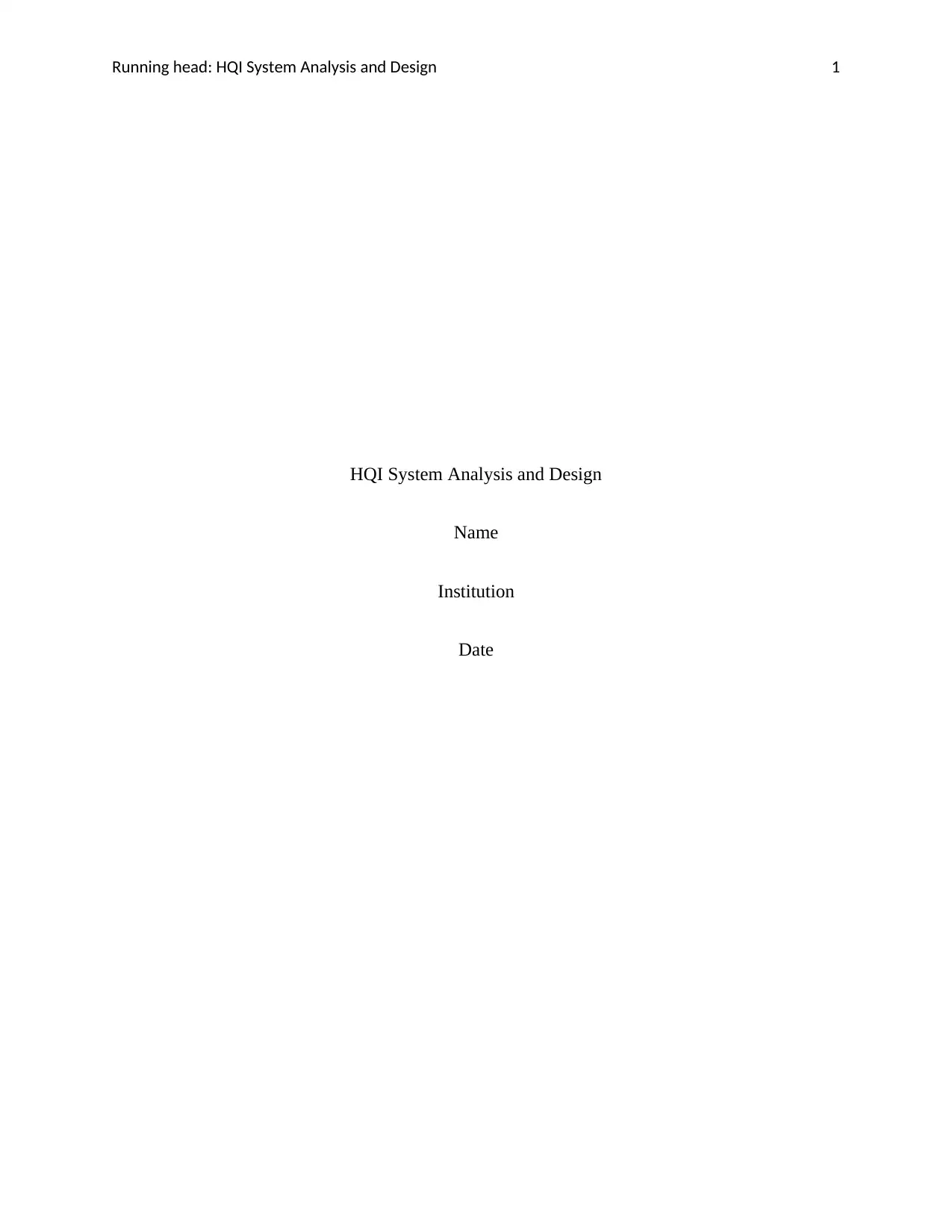
Running head: HQI System Analysis and Design 1
HQI System Analysis and Design
Name
Institution
Date
HQI System Analysis and Design
Name
Institution
Date
Paraphrase This Document
Need a fresh take? Get an instant paraphrase of this document with our AI Paraphraser
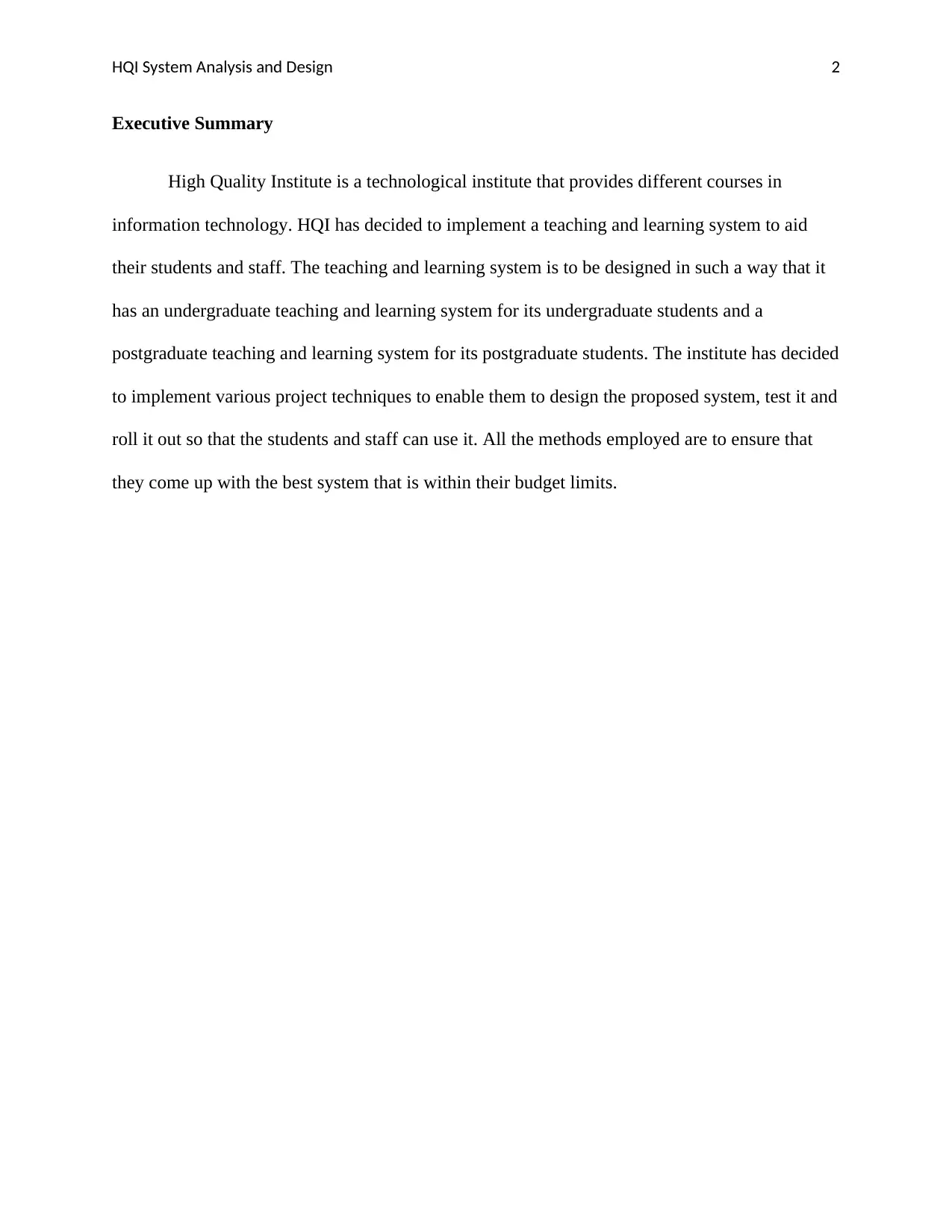
HQI System Analysis and Design 2
Executive Summary
High Quality Institute is a technological institute that provides different courses in
information technology. HQI has decided to implement a teaching and learning system to aid
their students and staff. The teaching and learning system is to be designed in such a way that it
has an undergraduate teaching and learning system for its undergraduate students and a
postgraduate teaching and learning system for its postgraduate students. The institute has decided
to implement various project techniques to enable them to design the proposed system, test it and
roll it out so that the students and staff can use it. All the methods employed are to ensure that
they come up with the best system that is within their budget limits.
Executive Summary
High Quality Institute is a technological institute that provides different courses in
information technology. HQI has decided to implement a teaching and learning system to aid
their students and staff. The teaching and learning system is to be designed in such a way that it
has an undergraduate teaching and learning system for its undergraduate students and a
postgraduate teaching and learning system for its postgraduate students. The institute has decided
to implement various project techniques to enable them to design the proposed system, test it and
roll it out so that the students and staff can use it. All the methods employed are to ensure that
they come up with the best system that is within their budget limits.
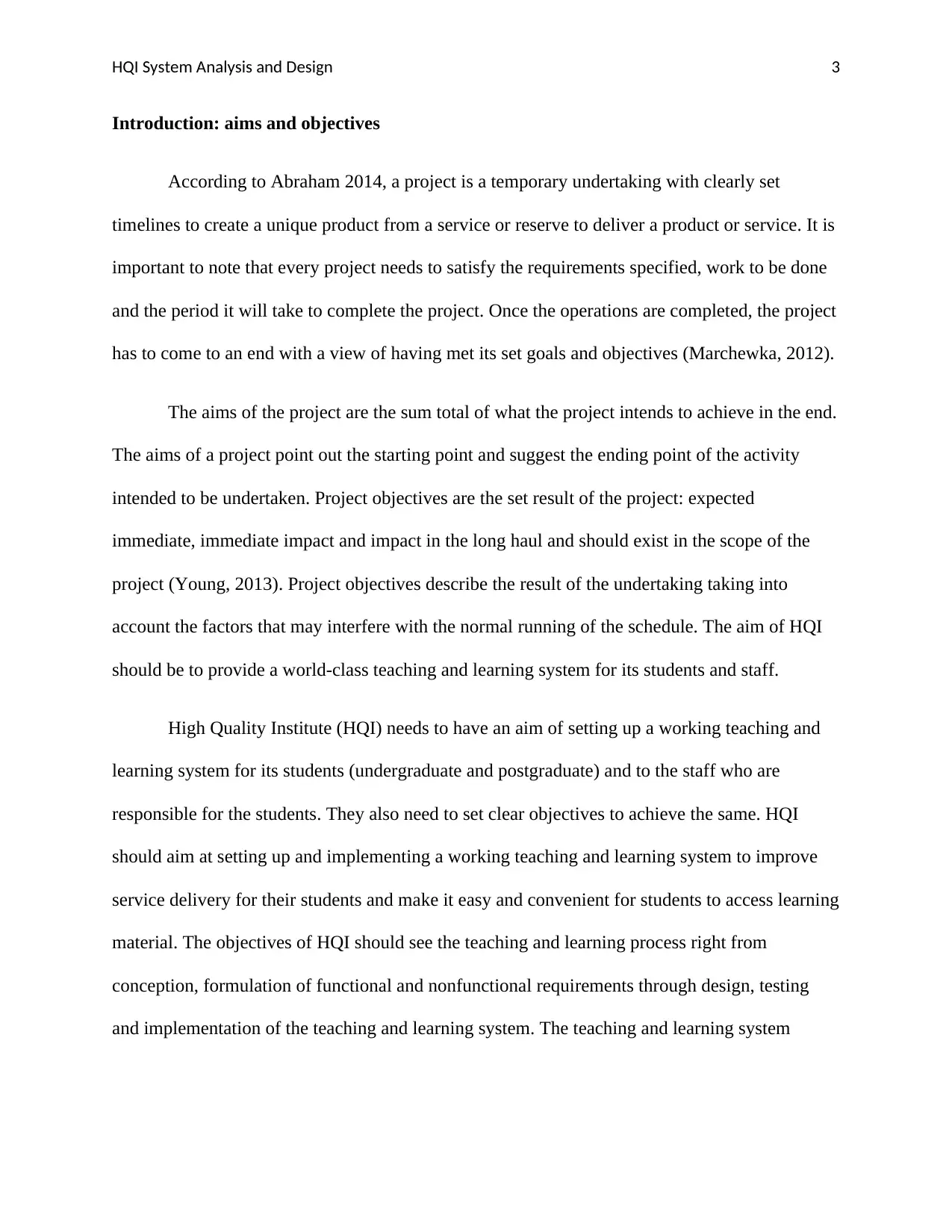
HQI System Analysis and Design 3
Introduction: aims and objectives
According to Abraham 2014, a project is a temporary undertaking with clearly set
timelines to create a unique product from a service or reserve to deliver a product or service. It is
important to note that every project needs to satisfy the requirements specified, work to be done
and the period it will take to complete the project. Once the operations are completed, the project
has to come to an end with a view of having met its set goals and objectives (Marchewka, 2012).
The aims of the project are the sum total of what the project intends to achieve in the end.
The aims of a project point out the starting point and suggest the ending point of the activity
intended to be undertaken. Project objectives are the set result of the project: expected
immediate, immediate impact and impact in the long haul and should exist in the scope of the
project (Young, 2013). Project objectives describe the result of the undertaking taking into
account the factors that may interfere with the normal running of the schedule. The aim of HQI
should be to provide a world-class teaching and learning system for its students and staff.
High Quality Institute (HQI) needs to have an aim of setting up a working teaching and
learning system for its students (undergraduate and postgraduate) and to the staff who are
responsible for the students. They also need to set clear objectives to achieve the same. HQI
should aim at setting up and implementing a working teaching and learning system to improve
service delivery for their students and make it easy and convenient for students to access learning
material. The objectives of HQI should see the teaching and learning process right from
conception, formulation of functional and nonfunctional requirements through design, testing
and implementation of the teaching and learning system. The teaching and learning system
Introduction: aims and objectives
According to Abraham 2014, a project is a temporary undertaking with clearly set
timelines to create a unique product from a service or reserve to deliver a product or service. It is
important to note that every project needs to satisfy the requirements specified, work to be done
and the period it will take to complete the project. Once the operations are completed, the project
has to come to an end with a view of having met its set goals and objectives (Marchewka, 2012).
The aims of the project are the sum total of what the project intends to achieve in the end.
The aims of a project point out the starting point and suggest the ending point of the activity
intended to be undertaken. Project objectives are the set result of the project: expected
immediate, immediate impact and impact in the long haul and should exist in the scope of the
project (Young, 2013). Project objectives describe the result of the undertaking taking into
account the factors that may interfere with the normal running of the schedule. The aim of HQI
should be to provide a world-class teaching and learning system for its students and staff.
High Quality Institute (HQI) needs to have an aim of setting up a working teaching and
learning system for its students (undergraduate and postgraduate) and to the staff who are
responsible for the students. They also need to set clear objectives to achieve the same. HQI
should aim at setting up and implementing a working teaching and learning system to improve
service delivery for their students and make it easy and convenient for students to access learning
material. The objectives of HQI should see the teaching and learning process right from
conception, formulation of functional and nonfunctional requirements through design, testing
and implementation of the teaching and learning system. The teaching and learning system
⊘ This is a preview!⊘
Do you want full access?
Subscribe today to unlock all pages.

Trusted by 1+ million students worldwide
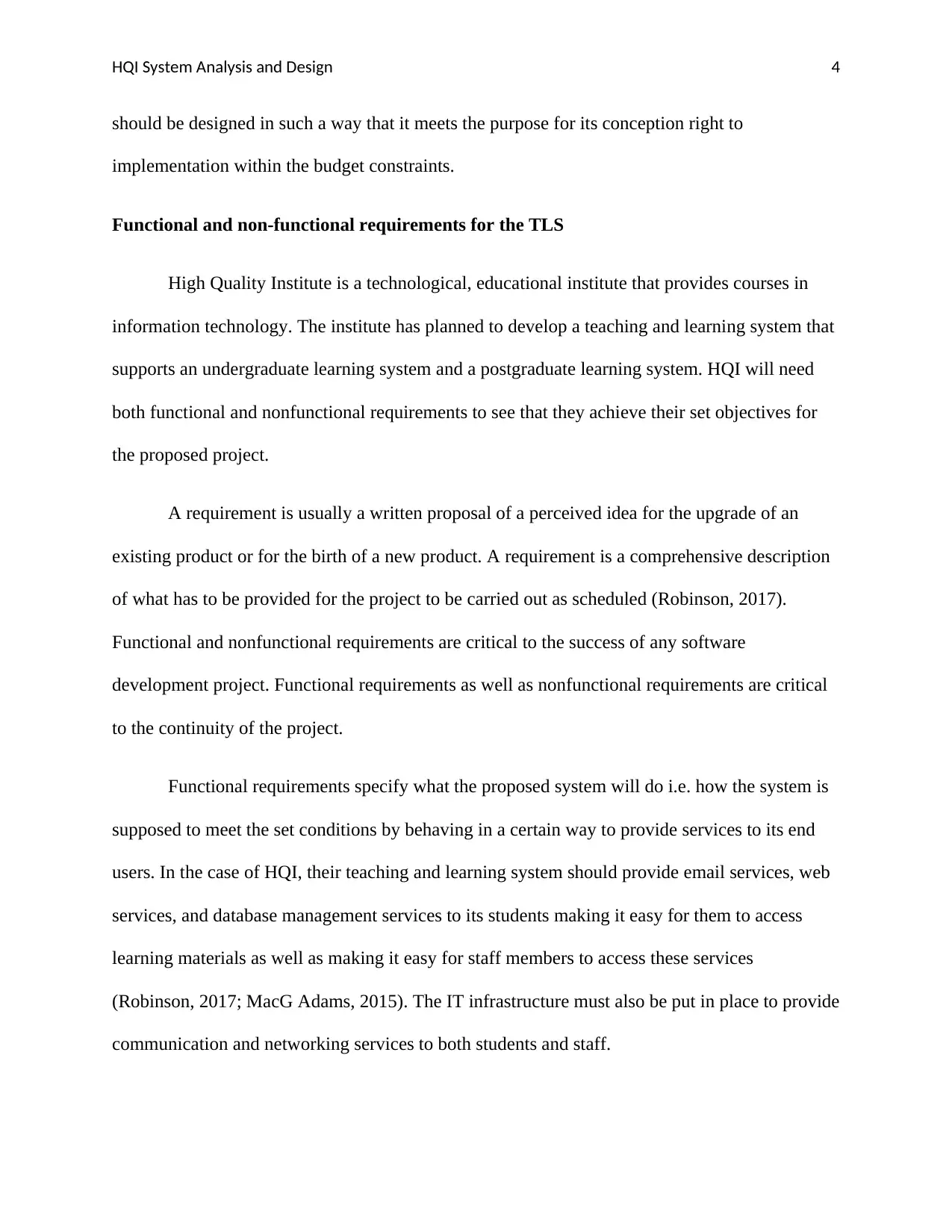
HQI System Analysis and Design 4
should be designed in such a way that it meets the purpose for its conception right to
implementation within the budget constraints.
Functional and non-functional requirements for the TLS
High Quality Institute is a technological, educational institute that provides courses in
information technology. The institute has planned to develop a teaching and learning system that
supports an undergraduate learning system and a postgraduate learning system. HQI will need
both functional and nonfunctional requirements to see that they achieve their set objectives for
the proposed project.
A requirement is usually a written proposal of a perceived idea for the upgrade of an
existing product or for the birth of a new product. A requirement is a comprehensive description
of what has to be provided for the project to be carried out as scheduled (Robinson, 2017).
Functional and nonfunctional requirements are critical to the success of any software
development project. Functional requirements as well as nonfunctional requirements are critical
to the continuity of the project.
Functional requirements specify what the proposed system will do i.e. how the system is
supposed to meet the set conditions by behaving in a certain way to provide services to its end
users. In the case of HQI, their teaching and learning system should provide email services, web
services, and database management services to its students making it easy for them to access
learning materials as well as making it easy for staff members to access these services
(Robinson, 2017; MacG Adams, 2015). The IT infrastructure must also be put in place to provide
communication and networking services to both students and staff.
should be designed in such a way that it meets the purpose for its conception right to
implementation within the budget constraints.
Functional and non-functional requirements for the TLS
High Quality Institute is a technological, educational institute that provides courses in
information technology. The institute has planned to develop a teaching and learning system that
supports an undergraduate learning system and a postgraduate learning system. HQI will need
both functional and nonfunctional requirements to see that they achieve their set objectives for
the proposed project.
A requirement is usually a written proposal of a perceived idea for the upgrade of an
existing product or for the birth of a new product. A requirement is a comprehensive description
of what has to be provided for the project to be carried out as scheduled (Robinson, 2017).
Functional and nonfunctional requirements are critical to the success of any software
development project. Functional requirements as well as nonfunctional requirements are critical
to the continuity of the project.
Functional requirements specify what the proposed system will do i.e. how the system is
supposed to meet the set conditions by behaving in a certain way to provide services to its end
users. In the case of HQI, their teaching and learning system should provide email services, web
services, and database management services to its students making it easy for them to access
learning materials as well as making it easy for staff members to access these services
(Robinson, 2017; MacG Adams, 2015). The IT infrastructure must also be put in place to provide
communication and networking services to both students and staff.
Paraphrase This Document
Need a fresh take? Get an instant paraphrase of this document with our AI Paraphraser
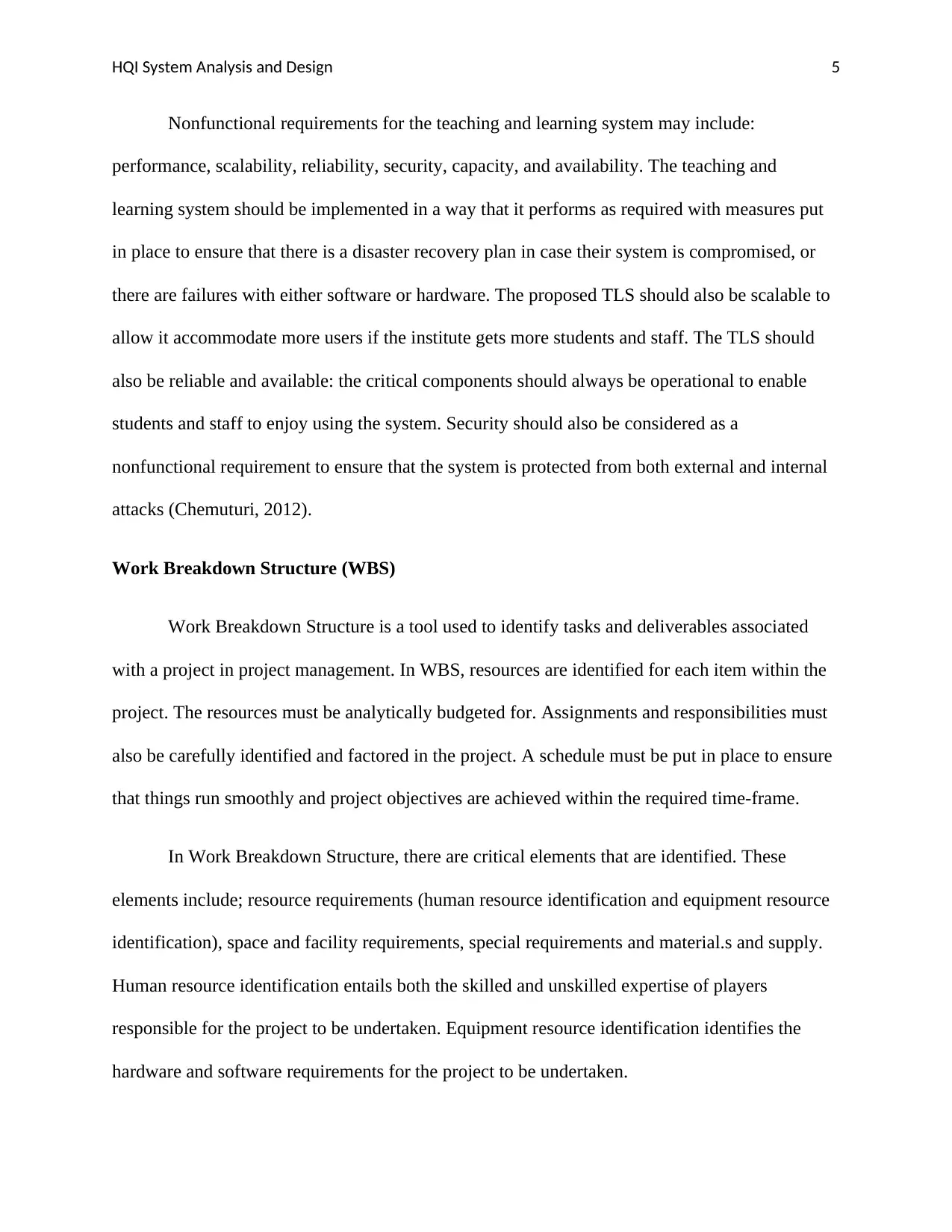
HQI System Analysis and Design 5
Nonfunctional requirements for the teaching and learning system may include:
performance, scalability, reliability, security, capacity, and availability. The teaching and
learning system should be implemented in a way that it performs as required with measures put
in place to ensure that there is a disaster recovery plan in case their system is compromised, or
there are failures with either software or hardware. The proposed TLS should also be scalable to
allow it accommodate more users if the institute gets more students and staff. The TLS should
also be reliable and available: the critical components should always be operational to enable
students and staff to enjoy using the system. Security should also be considered as a
nonfunctional requirement to ensure that the system is protected from both external and internal
attacks (Chemuturi, 2012).
Work Breakdown Structure (WBS)
Work Breakdown Structure is a tool used to identify tasks and deliverables associated
with a project in project management. In WBS, resources are identified for each item within the
project. The resources must be analytically budgeted for. Assignments and responsibilities must
also be carefully identified and factored in the project. A schedule must be put in place to ensure
that things run smoothly and project objectives are achieved within the required time-frame.
In Work Breakdown Structure, there are critical elements that are identified. These
elements include; resource requirements (human resource identification and equipment resource
identification), space and facility requirements, special requirements and material.s and supply.
Human resource identification entails both the skilled and unskilled expertise of players
responsible for the project to be undertaken. Equipment resource identification identifies the
hardware and software requirements for the project to be undertaken.
Nonfunctional requirements for the teaching and learning system may include:
performance, scalability, reliability, security, capacity, and availability. The teaching and
learning system should be implemented in a way that it performs as required with measures put
in place to ensure that there is a disaster recovery plan in case their system is compromised, or
there are failures with either software or hardware. The proposed TLS should also be scalable to
allow it accommodate more users if the institute gets more students and staff. The TLS should
also be reliable and available: the critical components should always be operational to enable
students and staff to enjoy using the system. Security should also be considered as a
nonfunctional requirement to ensure that the system is protected from both external and internal
attacks (Chemuturi, 2012).
Work Breakdown Structure (WBS)
Work Breakdown Structure is a tool used to identify tasks and deliverables associated
with a project in project management. In WBS, resources are identified for each item within the
project. The resources must be analytically budgeted for. Assignments and responsibilities must
also be carefully identified and factored in the project. A schedule must be put in place to ensure
that things run smoothly and project objectives are achieved within the required time-frame.
In Work Breakdown Structure, there are critical elements that are identified. These
elements include; resource requirements (human resource identification and equipment resource
identification), space and facility requirements, special requirements and material.s and supply.
Human resource identification entails both the skilled and unskilled expertise of players
responsible for the project to be undertaken. Equipment resource identification identifies the
hardware and software requirements for the project to be undertaken.
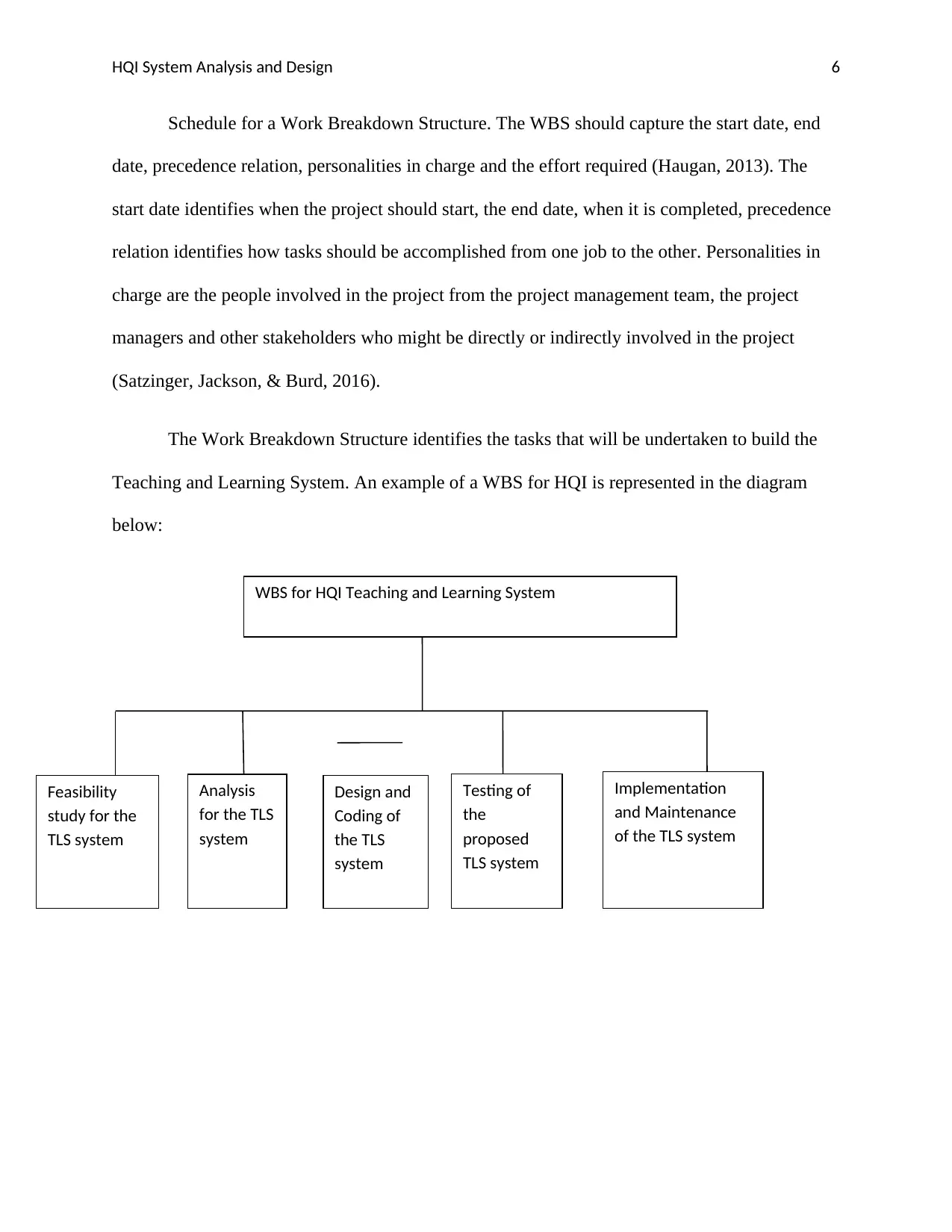
HQI System Analysis and Design 6
Schedule for a Work Breakdown Structure. The WBS should capture the start date, end
date, precedence relation, personalities in charge and the effort required (Haugan, 2013). The
start date identifies when the project should start, the end date, when it is completed, precedence
relation identifies how tasks should be accomplished from one job to the other. Personalities in
charge are the people involved in the project from the project management team, the project
managers and other stakeholders who might be directly or indirectly involved in the project
(Satzinger, Jackson, & Burd, 2016).
The Work Breakdown Structure identifies the tasks that will be undertaken to build the
Teaching and Learning System. An example of a WBS for HQI is represented in the diagram
below:
WBS for HQI Teaching and Learning System
Implementation
and Maintenance
of the TLS system
Analysis
for the TLS
system
Design and
Coding of
the TLS
system
Feasibility
study for the
TLS system
Testing of
the
proposed
TLS system
Schedule for a Work Breakdown Structure. The WBS should capture the start date, end
date, precedence relation, personalities in charge and the effort required (Haugan, 2013). The
start date identifies when the project should start, the end date, when it is completed, precedence
relation identifies how tasks should be accomplished from one job to the other. Personalities in
charge are the people involved in the project from the project management team, the project
managers and other stakeholders who might be directly or indirectly involved in the project
(Satzinger, Jackson, & Burd, 2016).
The Work Breakdown Structure identifies the tasks that will be undertaken to build the
Teaching and Learning System. An example of a WBS for HQI is represented in the diagram
below:
WBS for HQI Teaching and Learning System
Implementation
and Maintenance
of the TLS system
Analysis
for the TLS
system
Design and
Coding of
the TLS
system
Feasibility
study for the
TLS system
Testing of
the
proposed
TLS system
⊘ This is a preview!⊘
Do you want full access?
Subscribe today to unlock all pages.

Trusted by 1+ million students worldwide
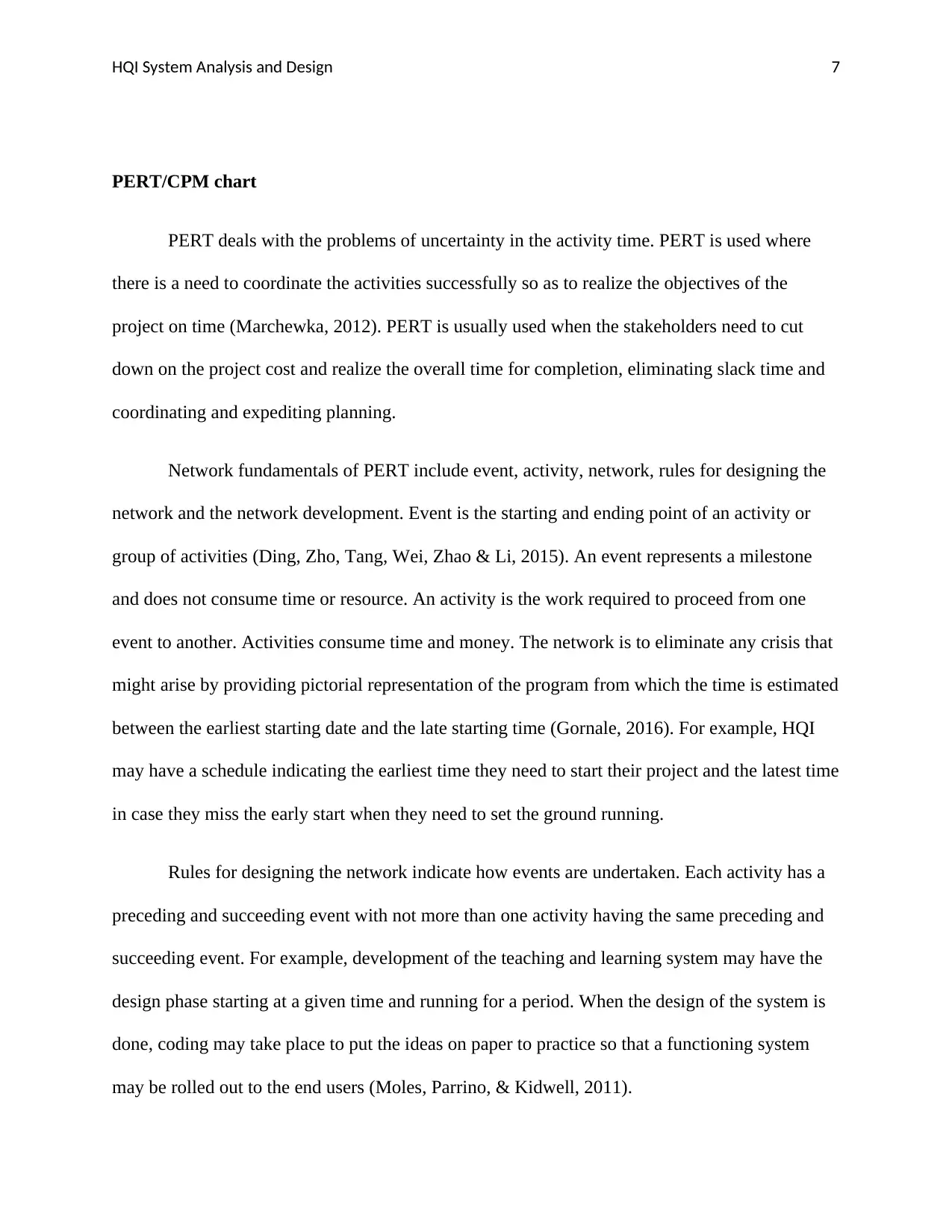
HQI System Analysis and Design 7
PERT/CPM chart
PERT deals with the problems of uncertainty in the activity time. PERT is used where
there is a need to coordinate the activities successfully so as to realize the objectives of the
project on time (Marchewka, 2012). PERT is usually used when the stakeholders need to cut
down on the project cost and realize the overall time for completion, eliminating slack time and
coordinating and expediting planning.
Network fundamentals of PERT include event, activity, network, rules for designing the
network and the network development. Event is the starting and ending point of an activity or
group of activities (Ding, Zho, Tang, Wei, Zhao & Li, 2015). An event represents a milestone
and does not consume time or resource. An activity is the work required to proceed from one
event to another. Activities consume time and money. The network is to eliminate any crisis that
might arise by providing pictorial representation of the program from which the time is estimated
between the earliest starting date and the late starting time (Gornale, 2016). For example, HQI
may have a schedule indicating the earliest time they need to start their project and the latest time
in case they miss the early start when they need to set the ground running.
Rules for designing the network indicate how events are undertaken. Each activity has a
preceding and succeeding event with not more than one activity having the same preceding and
succeeding event. For example, development of the teaching and learning system may have the
design phase starting at a given time and running for a period. When the design of the system is
done, coding may take place to put the ideas on paper to practice so that a functioning system
may be rolled out to the end users (Moles, Parrino, & Kidwell, 2011).
PERT/CPM chart
PERT deals with the problems of uncertainty in the activity time. PERT is used where
there is a need to coordinate the activities successfully so as to realize the objectives of the
project on time (Marchewka, 2012). PERT is usually used when the stakeholders need to cut
down on the project cost and realize the overall time for completion, eliminating slack time and
coordinating and expediting planning.
Network fundamentals of PERT include event, activity, network, rules for designing the
network and the network development. Event is the starting and ending point of an activity or
group of activities (Ding, Zho, Tang, Wei, Zhao & Li, 2015). An event represents a milestone
and does not consume time or resource. An activity is the work required to proceed from one
event to another. Activities consume time and money. The network is to eliminate any crisis that
might arise by providing pictorial representation of the program from which the time is estimated
between the earliest starting date and the late starting time (Gornale, 2016). For example, HQI
may have a schedule indicating the earliest time they need to start their project and the latest time
in case they miss the early start when they need to set the ground running.
Rules for designing the network indicate how events are undertaken. Each activity has a
preceding and succeeding event with not more than one activity having the same preceding and
succeeding event. For example, development of the teaching and learning system may have the
design phase starting at a given time and running for a period. When the design of the system is
done, coding may take place to put the ideas on paper to practice so that a functioning system
may be rolled out to the end users (Moles, Parrino, & Kidwell, 2011).
Paraphrase This Document
Need a fresh take? Get an instant paraphrase of this document with our AI Paraphraser
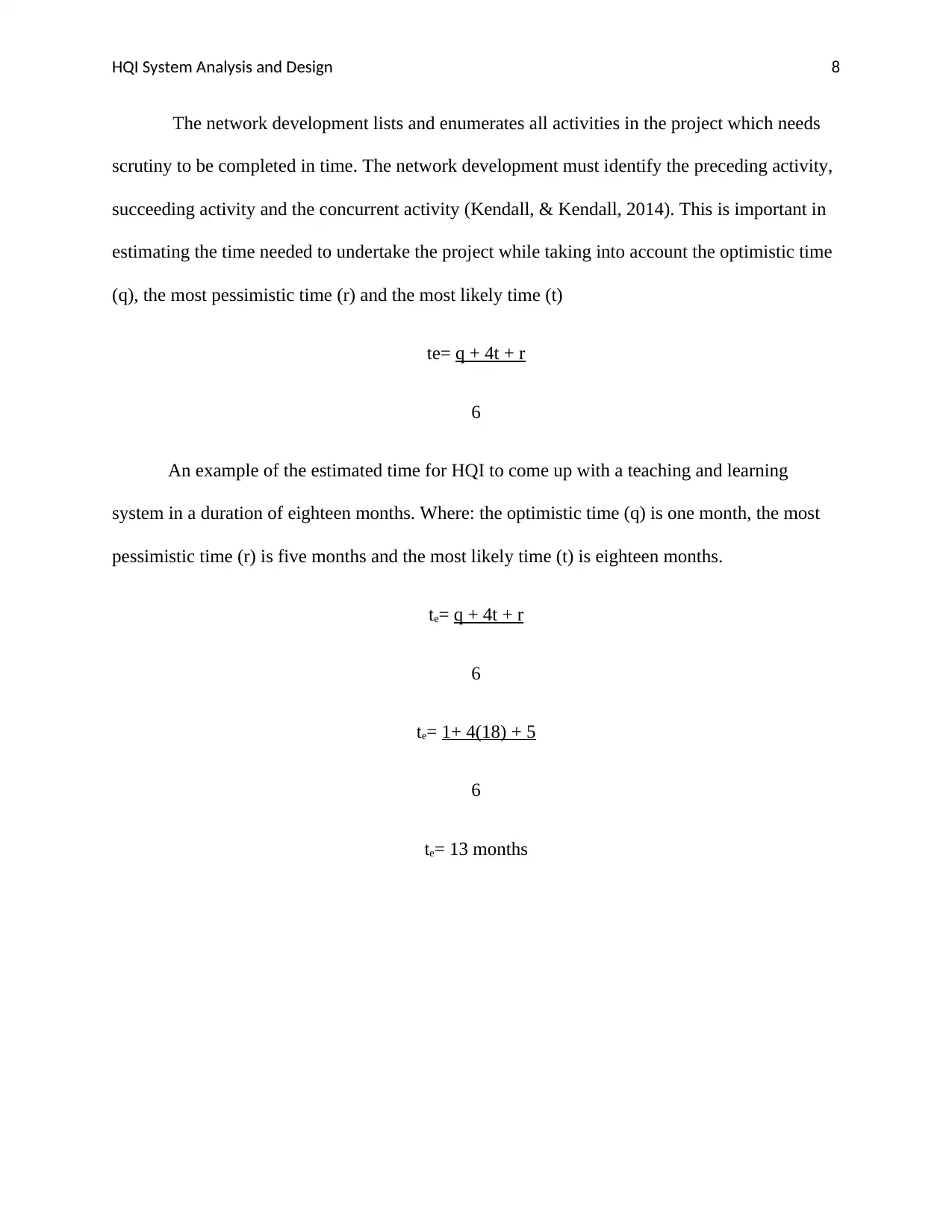
HQI System Analysis and Design 8
The network development lists and enumerates all activities in the project which needs
scrutiny to be completed in time. The network development must identify the preceding activity,
succeeding activity and the concurrent activity (Kendall, & Kendall, 2014). This is important in
estimating the time needed to undertake the project while taking into account the optimistic time
(q), the most pessimistic time (r) and the most likely time (t)
te= q + 4t + r
6
An example of the estimated time for HQI to come up with a teaching and learning
system in a duration of eighteen months. Where: the optimistic time (q) is one month, the most
pessimistic time (r) is five months and the most likely time (t) is eighteen months.
te= q + 4t + r
6
te= 1+ 4(18) + 5
6
te= 13 months
The network development lists and enumerates all activities in the project which needs
scrutiny to be completed in time. The network development must identify the preceding activity,
succeeding activity and the concurrent activity (Kendall, & Kendall, 2014). This is important in
estimating the time needed to undertake the project while taking into account the optimistic time
(q), the most pessimistic time (r) and the most likely time (t)
te= q + 4t + r
6
An example of the estimated time for HQI to come up with a teaching and learning
system in a duration of eighteen months. Where: the optimistic time (q) is one month, the most
pessimistic time (r) is five months and the most likely time (t) is eighteen months.
te= q + 4t + r
6
te= 1+ 4(18) + 5
6
te= 13 months
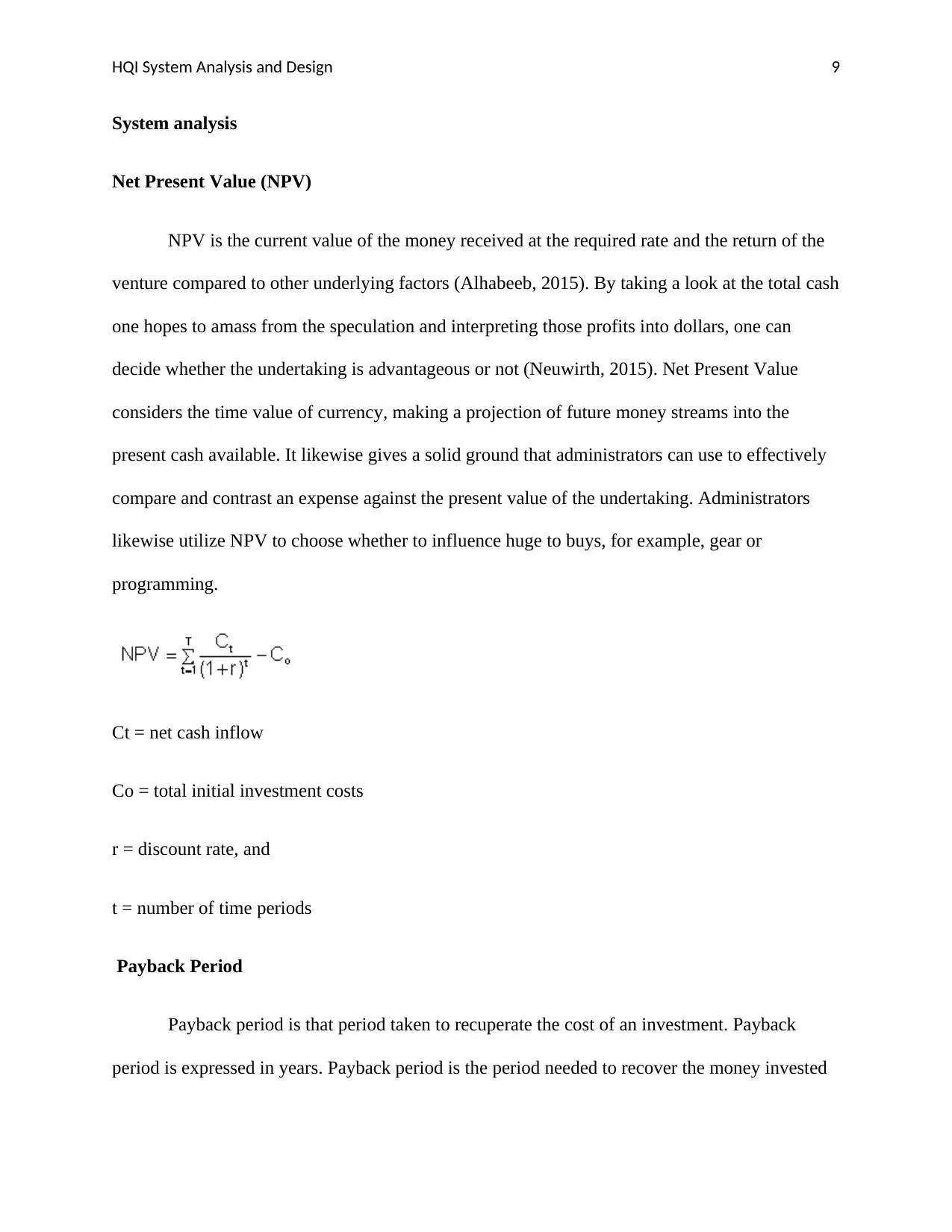
HQI System Analysis and Design 9
System analysis
Net Present Value (NPV)
NPV is the current value of the money received at the required rate and the return of the
venture compared to other underlying factors (Alhabeeb, 2015). By taking a look at the total cash
one hopes to amass from the speculation and interpreting those profits into dollars, one can
decide whether the undertaking is advantageous or not (Neuwirth, 2015). Net Present Value
considers the time value of currency, making a projection of future money streams into the
present cash available. It likewise gives a solid ground that administrators can use to effectively
compare and contrast an expense against the present value of the undertaking. Administrators
likewise utilize NPV to choose whether to influence huge to buys, for example, gear or
programming.
Ct = net cash inflow
Co = total initial investment costs
r = discount rate, and
t = number of time periods
Payback Period
Payback period is that period taken to recuperate the cost of an investment. Payback
period is expressed in years. Payback period is the period needed to recover the money invested
System analysis
Net Present Value (NPV)
NPV is the current value of the money received at the required rate and the return of the
venture compared to other underlying factors (Alhabeeb, 2015). By taking a look at the total cash
one hopes to amass from the speculation and interpreting those profits into dollars, one can
decide whether the undertaking is advantageous or not (Neuwirth, 2015). Net Present Value
considers the time value of currency, making a projection of future money streams into the
present cash available. It likewise gives a solid ground that administrators can use to effectively
compare and contrast an expense against the present value of the undertaking. Administrators
likewise utilize NPV to choose whether to influence huge to buys, for example, gear or
programming.
Ct = net cash inflow
Co = total initial investment costs
r = discount rate, and
t = number of time periods
Payback Period
Payback period is that period taken to recuperate the cost of an investment. Payback
period is expressed in years. Payback period is the period needed to recover the money invested
⊘ This is a preview!⊘
Do you want full access?
Subscribe today to unlock all pages.

Trusted by 1+ million students worldwide
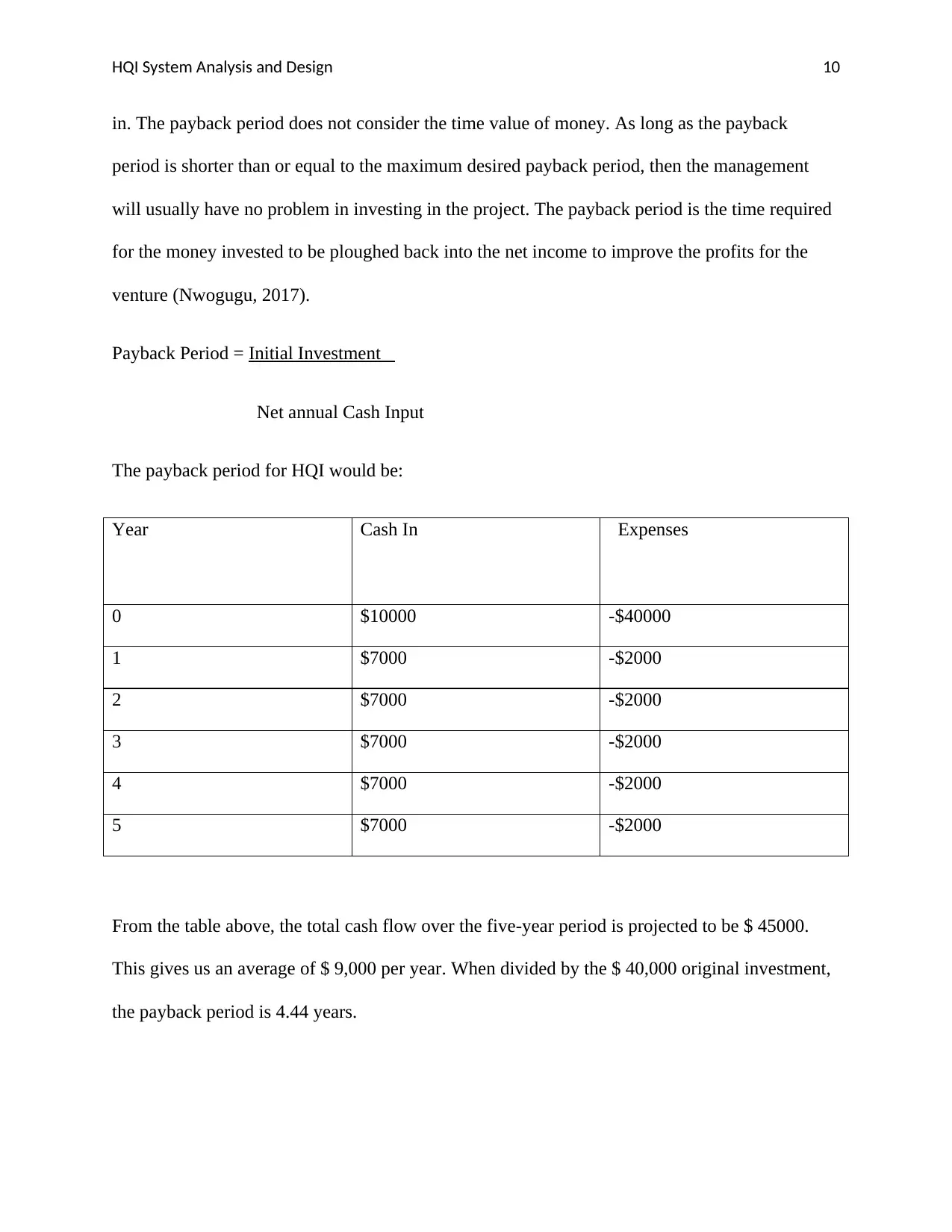
HQI System Analysis and Design 10
in. The payback period does not consider the time value of money. As long as the payback
period is shorter than or equal to the maximum desired payback period, then the management
will usually have no problem in investing in the project. The payback period is the time required
for the money invested to be ploughed back into the net income to improve the profits for the
venture (Nwogugu, 2017).
Payback Period = Initial Investment
Net annual Cash Input
The payback period for HQI would be:
Year Cash In Expenses
0 $10000 -$40000
1 $7000 -$2000
2 $7000 -$2000
3 $7000 -$2000
4 $7000 -$2000
5 $7000 -$2000
From the table above, the total cash flow over the five-year period is projected to be $ 45000.
This gives us an average of $ 9,000 per year. When divided by the $ 40,000 original investment,
the payback period is 4.44 years.
in. The payback period does not consider the time value of money. As long as the payback
period is shorter than or equal to the maximum desired payback period, then the management
will usually have no problem in investing in the project. The payback period is the time required
for the money invested to be ploughed back into the net income to improve the profits for the
venture (Nwogugu, 2017).
Payback Period = Initial Investment
Net annual Cash Input
The payback period for HQI would be:
Year Cash In Expenses
0 $10000 -$40000
1 $7000 -$2000
2 $7000 -$2000
3 $7000 -$2000
4 $7000 -$2000
5 $7000 -$2000
From the table above, the total cash flow over the five-year period is projected to be $ 45000.
This gives us an average of $ 9,000 per year. When divided by the $ 40,000 original investment,
the payback period is 4.44 years.
Paraphrase This Document
Need a fresh take? Get an instant paraphrase of this document with our AI Paraphraser

HQI System Analysis and Design 11
Return on Investment (ROI)
Return on Investment (ROI) is a tool used by investors to calculate the profitability of a
venture. ROI is used to calculate the profits of an investment as a percentage of the original cost
(Brealey, Myers & Allen, 2017 ; Carrie, 2017). ROI shows how money is made on an
investment. ROI is calculated as a percentage of the purchase price. ROI is used to forecast
profitability (Phillips, 2012).
ROI = Gain from an Investment - Cost of an Investment
Cost of an Investment
Return on Investment for HQI in the first year would be:
Gain from investment = 7000
Cost of Investment = 2000
ROI = 7000 – 2000
2000
= 2.5%
Return on Investment (ROI)
Return on Investment (ROI) is a tool used by investors to calculate the profitability of a
venture. ROI is used to calculate the profits of an investment as a percentage of the original cost
(Brealey, Myers & Allen, 2017 ; Carrie, 2017). ROI shows how money is made on an
investment. ROI is calculated as a percentage of the purchase price. ROI is used to forecast
profitability (Phillips, 2012).
ROI = Gain from an Investment - Cost of an Investment
Cost of an Investment
Return on Investment for HQI in the first year would be:
Gain from investment = 7000
Cost of Investment = 2000
ROI = 7000 – 2000
2000
= 2.5%
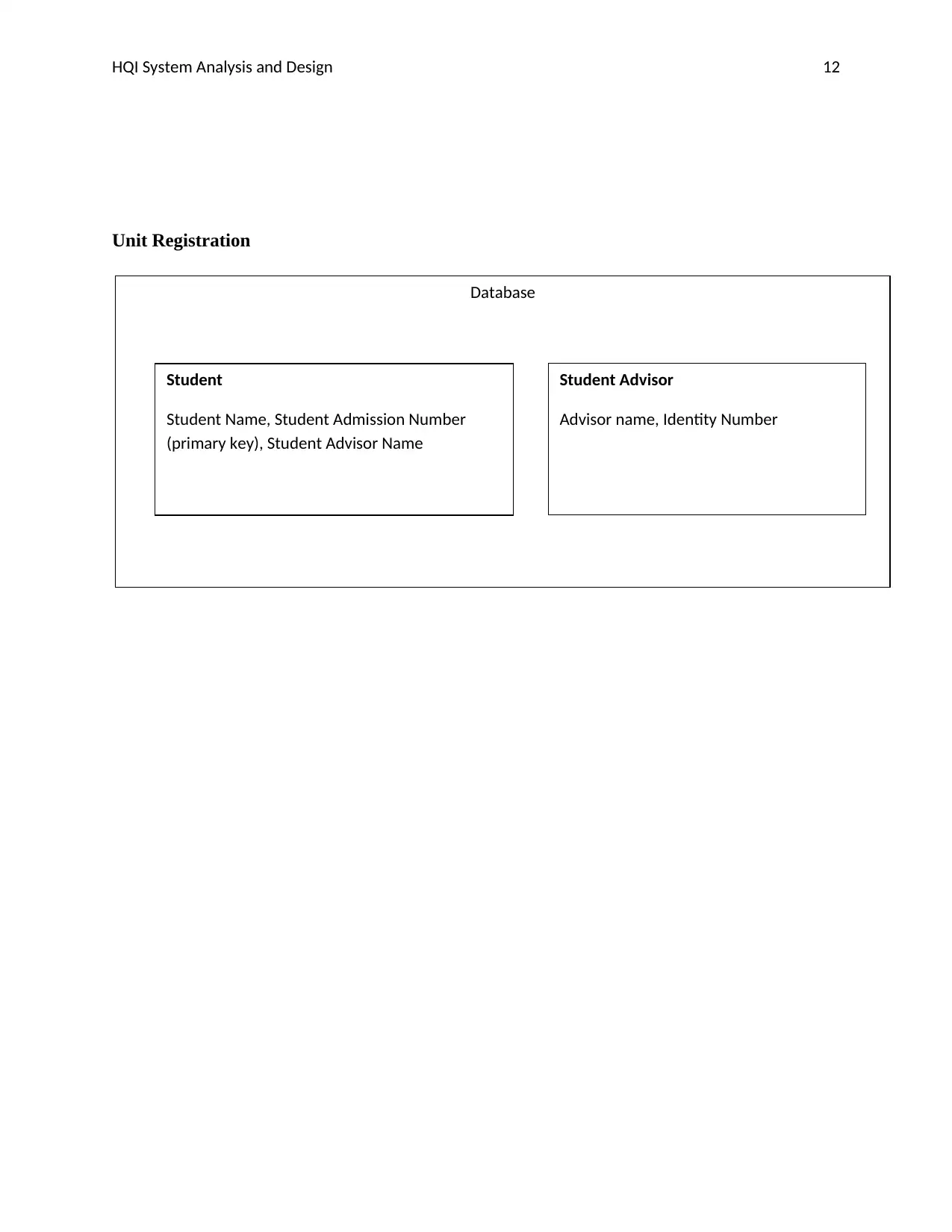
HQI System Analysis and Design 12
Unit Registration
Database
Student
Student Name, Student Admission Number
(primary key), Student Advisor Name
Student Advisor
Advisor name, Identity Number
Unit Registration
Database
Student
Student Name, Student Admission Number
(primary key), Student Advisor Name
Student Advisor
Advisor name, Identity Number
⊘ This is a preview!⊘
Do you want full access?
Subscribe today to unlock all pages.

Trusted by 1+ million students worldwide
1 out of 16
Related Documents
Your All-in-One AI-Powered Toolkit for Academic Success.
+13062052269
info@desklib.com
Available 24*7 on WhatsApp / Email
![[object Object]](/_next/static/media/star-bottom.7253800d.svg)
Unlock your academic potential
Copyright © 2020–2025 A2Z Services. All Rights Reserved. Developed and managed by ZUCOL.





